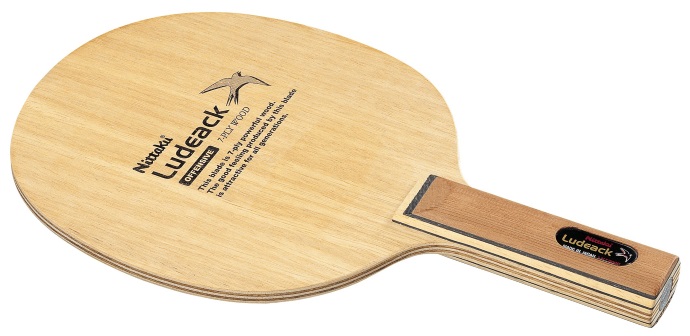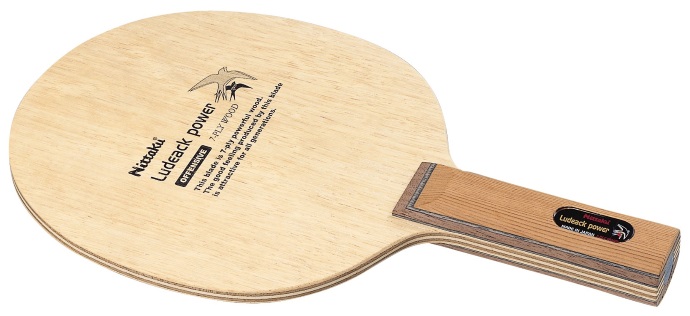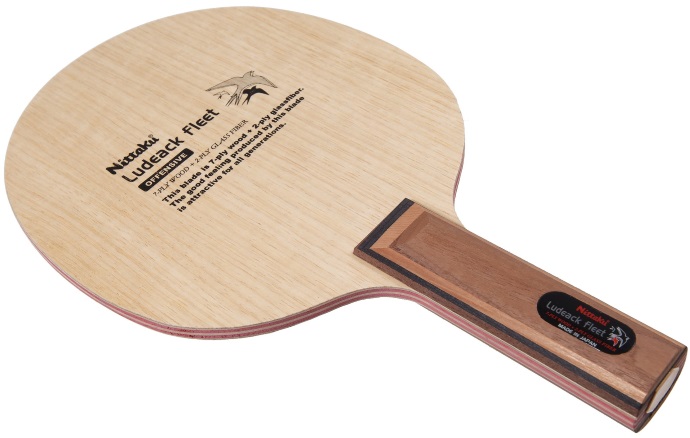Nittaku Ludeack, Ludeack Power, and Ludeack Fleet Blades Review
31 October 2017 | Posted in: Table Tennis Reviews
About the Reviewer
 Patrick Hrdlicka is a table tennis enthusiast, who was introduced to the sport by his parents at the age of six. Patrick progressed to play in the highest national cadet and junior team leagues in his native Denmark and was among the top 40 players in his age group, which fostered several long-standing members of the Danish National Team. With college looming, Patrick quit the sport for almost twenty years. During this hiatus, he obtained a Ph.D.-degree in chemistry and accepted a position as professor of chemistry at the University of Idaho.
Patrick Hrdlicka is a table tennis enthusiast, who was introduced to the sport by his parents at the age of six. Patrick progressed to play in the highest national cadet and junior team leagues in his native Denmark and was among the top 40 players in his age group, which fostered several long-standing members of the Danish National Team. With college looming, Patrick quit the sport for almost twenty years. During this hiatus, he obtained a Ph.D.-degree in chemistry and accepted a position as professor of chemistry at the University of Idaho.
At the beginning of 2014, the mid-life crisis and yearning for table tennis grew too strong for Patrick and he decided to pick up the sport again. Bitten again by the table tennis bug, he plays 4-6 times per week.
Since his comeback to table tennis, he has enjoyed combining his analytical and experimental skills with his love for table tennis, testing and reviewing a wide range of table tennis equipment.
Introduction
In this test, I was given the opportunity to evaluate the Nittaku Ludeack blade series, i.e., the regular Ludeack, the Ludeack Power, and the Ludeack Fleet. I was excited about this opportunity since these Japan-made blades are well-known for their excellent playing characteristics and renowned among short pip players. Nittaku describes the regular Ludeack as a 7-ply blade with a mid speed rating and middle feeling for players with power. The Ludeack Power, which also is a 7-ply all-wood blade, is described as being based on the Ludeack but with a greater focus on speed having a mid-fast speed rating and hard feel. The glassfiber-reinforced Ludeack Fleet is described as a mid-fast 7+2-ply blade with a hard feeling that is especially geared towards top players craving power and spin.
The blades come in Nittaku’s standard box, which is kept in silver and blue color tones with key blade characteristics listed on the front. The names of the blades and a summary of their characteristics are listed on the FH side of the blades. The playing surfaces of all three blades have a very light color and are exceptionally smooth. The wings are sanded very minimally, if at all. Overall, the build quality of these blades appears to be outstanding.
The ply constructions of these blades, deserve further discussion. The Ludeack and Ludeack Power are 7-ply all-wood blades with a classic limba-ayous-ayous-ayous-ayous-ayous-limba construction. Followers of this blog will know that I have recently tested a series of 7-ply blades with the same ply composition, i.e., the DHS Power G7 OFF+, DHS Hurricane Long 3, and Tibhar Samsonov Force Pro Black Edition blades. The DHS blades have a thick core, which is surrounded by very thin red-colored plies, followed by a ply of similar thickness, and finally an ultra thin outer ply (i.e., ultra thin-very thin-very thin-thick-very thin-very thin-ultra thin). By comparison, the Tibhar blade has a thinner core, markedly thicker red plies, a very thin penultimate layer, and a slightly more robust outer layer (i.e., ultra thin-very thin-medium-medium-medium-very thin-ultra thin). Interestingly, the Ludeack has complete different ply thicknesses. Thus, the inner 5-plies have a similar thickness (the ones surrounding the core are dyed light-brown) and are capped off with an ultra-thin outer ply (i.e., ultra thin-thin-thin-thin-thin-thin-ultra thin). The ply construction of the Ludeack Power is quite similar to the Tibhar blade, except that the core is slightly thicker and the plies surrounding the core are dyed light-brown (i.e., ultra thin-very thin-medium-medium thick-medium-very thin-ultra thin). The Ludeack Fleet is a 7+2-ply blade with a limba-glassfiber-ayous-ayous-ayous-ayous-ayous-glassfiber-limba construction. It is unusual in that the red plies surrounding the core are thicker than the central ply. The three outer plies, i.e., the limba-glassfiber-ayous are extremely thin (i.e., ultra thin-ultra thin-very thin-medium-thin-medium-very thin-ultra thin-ultra thin). This detailed analysis goes to show that there can be substantial differences between blades even though they have the same general ply composition.
Testing procedure
I tested these blades using a regular DHS Hurricane 3 Neo (2.15 mm, black) and Spinlord Waran (1.8 mm, red) short pips in my FH and BH, respectively. As always, I attached the rubbers using the Revolution 3 normal viscosity glue. I evaluated each blade over ~3 sessions, playing a mix of simple drills and matches against my regular practice partners using Nittaku J-Top 40+ plastic balls.
Nittaku Ludeack – A Control-Oriented 7-Ply All-Wood Blade With a Crisp Feeling Suitable for a Wide Range of Styles
The Nittaku Ludeack has a playing surface that is 156x151 mm and a thickness of 6.5 mm. The test blade weighed 85 g. The handle has a beautiful rustic look and is kept in a dark-brown color. There is a black lens on the front with golden and red text, and a black and silver Nittaku tag and JTTAA stamp on the on the bottom. The FL handle is a little longer than usual and exceptionally pleasant to hold (length x width x height: 102 mm x 26-33 mm x 24 mm). Bouncing a ball on the naked blade produces a pitch that is higher than DHS’ Hurricane Long 3 and PG7 but lower than Tibhar’s Samsonov Force Pro Black edition. The test set-up felt well-balanced with only a slight head heaviness to it.
Playing impressions
The Ludeack produces a crisp and direct contact on FH and – especially – BH drives, which affords an excellent feeling of the ball. The blade is only moderately fast, I would say low-to-mid OFF-, but it really delivers in the control segment. FH and BH drives were near-impossible to miss with this blade. While the Ludeack is best suited close to the table and mid-distance, it still delivers from distances although greater physical effort is required. Even though the contact point is crisp, there is plenty of dwell time for generous spin generation. Accordingly, the blade produces a surprisingly high arc on FH loops against heavy backspin with plenty of clearance over the net, making it a pleasure to play with against long pips choppers. The above-average arc was also apparent on BH short pip drives and ‘loops’, which rarely got caught in the net. Passive blocking with the Ludeack is very pleasant because the OFF- speed and crisp contact point allows you to take the pace off the ball and direct it in the desired direction. The only moderate speed of the blade is particularly apparent on FH flat hits, as I found it difficult to make outright winners. Rather than employing brute force, I used the blade’s excellent control to precisely place the ball out of reach for my opponents. Touch shots and short game, on the other hand, are exceptionally easy with the Ludeack. Low and short serve return pushes and multi-bounce drop shots are near-effortless. Aggressive serve returns are also easy to execute due to the blade’s excellent control but perhaps lacked a little bit in depth and raw speed. Just for fun, I also tried to chop with my Waran short pips far from the table against FH loops and found the control to be exquisite, allowing me to play consistent, flat and spinny chops that were challenging to return. Serving with the Ludeack is great as the dwell time allows for efficient spin generation.

Conclusion
The Nittaku Ludeack is one of the most pleasant blades that I have tried. It offers OFF- speed with ALL-like control. It is well-suited for a very wide range of players, ranging from two-winged loopers playing with fast European or Japanese rubbers, players using short pips on one side, and even modern defenders. Players who use slower Chinese rubbers and/or who base their game on hard loop drives will likely find this blade to be too slow. Compared to other 7-ply blades, I would describe the Ludeack as a slightly faster and crisper feeling version of the DHS Power G7, or a slower version of the Tibhar Samsonov Force Pro Black Edition. Highly recommended.
Read Nittaku Ludeack Customer Reviews & Get Our Best Price >>
Nittaku Ludeack Power – A Middle-of-the-Road 7-Ply Blade
The Ludeack Power has a playing surface that is slightly larger than the regular Ludeack (158x152 mm) and is also slightly thicker at 6.6 mm. The test blade weighed 85 g. The handle has a beautiful vertical wood grain and is kept in a light-brown color. Just as the regular Ludeack, it has a black lens with golden and red text on the front, and a black and silver Nittaku tag and JTTAA stamp on the bottom of the blade. The dimensions of the FL handle of the Ludeack Power are similar to those of the regular Ludeack (length x width x height: 102 mm x 25-32 mm x 24 mm). To my surprise, the pitch produced by bouncing a ball on the naked blade is significantly lower than with the Ludeack or DHS Hurricane Long 3, which suggests that the blade is slower and/or the outer plies are softer. The test set-up felt heavier and not quite as well-balanced as the regular Ludeack, possibly due to the larger head size.
Playing impressions
Given that I really enjoyed the feeling of the regular Ludeack but found it a little lacking in the speed department in combination with a Hurricane 3 Neo rubber, I was super excited about the potential of the Ludeack Power. Indeed, the blade is slightly faster than the regular Ludeack (roughly mid OFF-) but the feeling is more solid and muted. For sure, FH and BH drives can be played competently both close to the table and from mid-distance, but the muted feeling almost gives the impression that the blade is slower than it really is. FH loops played with the Ludeack Power are slightly faster and flatter, but the muted feeling did not provide me enough immediate feedback on whether I used the correct bat angle. For being a 7-ply blade, the Ludeack Power still offers considerable flexibility, average dwell time, and does not feel stiff. My practice partners reported that high-impact loop drives felt more spinny and had more kick to them than with the regular Ludeack. FH and BH blocking is solid and controlled but I, once again, found myself longing for a more crisp contact point to help guide my active blocks around the table. Flat hits are solid, controllable, and reasonably – but far from blistering – fast. Service returns and touch shots are easy to execute with the Ludeack Power. However, the slightly higher speed, lower control, and more muted feeling of the blade meant I preferred the regular Ludeack for these shots. An average level of spin can be imparted on serves using the Ludeack Power.

Conclusion
Players who enjoy a more solid feeling upon hitting the ball will enjoy the Ludeack Power. Perhaps the most remarkable characteristic of the Nittaku Ludeack Power is that it does not have a unique strength or characteristic that sets it apart from the other 7-ply blades that I have tried. In other words, it feels average. In my opinion, the Nittaku Ludeack Power is best suited for more passive players using medium-soft to medium-hard rubbers. with built-in catapult effect than hard and tacky Chinese rubbers.
Read Nittaku Ludeack Power Customer Reviews & Get Our Best Price >>
Nittaku Ludeack Fleet – Like a Regular Ludeack but With a Kick
The Ludeack Fleet has a regularly sized playing surface (157x151 mm) and is thinner than the other members of the Ludeack family, with a thickness of 6.2 mm. The test blade weighed 88 g. The handle is brown with black vertical stripes on either side. The blade has a black lens with silver and red text on the front, and a golden Nittaku tag and JTTAA stamp on the bottom. The FL handle dimensions are similar to the other Ludeack blades (length x width x height: 102 mm x 26-35 mm x 24 mm). Contrary to my expectations, the pitch produced by bouncing a ball on the naked blade is rather low and very similar to the Ludeack Power, suggesting a relatively slow and/or soft blade. The balance of the test setup was nice and quite similar to the regular Ludeack, i.e., slightly tilted towards the head.
Playing impressions
Followers of this blog will know that I am inherently skeptical of composite blades as they frequently feel too disengaged for my taste. However, the glassfiber-reinforced 7+2 ply Nittaku Ludeack Fleet does not fall into this category. The feeling on FH and BH drives is quite crisp and similar to that of a regular Ludeack, and the shots are ~5-10% faster (mid-to-fast OFF- range). Unfortunately, the gain in power is accompanied by a marked loss of control relative to the regular Ludeack. Simple shots like FH and BH drives can still be played with high consistency, and there is plenty of power to play both close to the table as well as from mid- and long-distance. FH loops against heavy backspin feel relatively crisp and result in a relatively long and flat trajectory. The dwell time is shorter than with the regular Ludeack, and less spin is accordingly generated on low-to-medium impact FH loops, whereas high-impact loop-drives have greater penetrating power. The higher speed, flatter curve, and lower control of the Ludeack Fleet renders it more likely to overshot the table, especially since a slight kick is activated on high-impact shots. The feeling on blocking was crisp and allowed for shots to be played in a reasonably controlled manner, especially with Waran short pips, although once again care must be taken not to overshoot the table. Flat hits are considerably faster than with the regular Ludeack but slower than with other composite blades, such as the Victas Koki Niwa, Donic Ovtcharov True Carbon or DHS Hurricane Long 5. Short serve returns and touch play are reasonably easy to play, although they tend to be slightly longer than with the regular Ludeack. The slightly shorter dwell time means that slightly less spin is produced on serves. On the other hand, fast, deep serves are a pleasure to play with this blade.

Conclusion
The Nittaku Ludeack Fleet is a faster version of the original Ludeack that maintains a similarly crisp feeling. The trade-off, unfortunately, is a marked decrease in control. In particular, the longer trajectory might require some adjustments. However, aggressive players who find the regular Ludeack too slow for their style – especially those using slower rubbers - should give the Nittaku Ludeack Fleet serious consideration.
Read Nittaku Ludeack Fleet Customer Reviews & Get Our Best Price >>
Compared to some of the other 7-ply blades that I have recently reviewed, I would place the Ludeack series as follows.
Speed: Tibhar Samsonov Force Pro Black Edition > Nittaku Ma Long Seven> DHS Hurricane Long 3 ≈ Nittaku Ludeack Fleet ≈ Nittaku Ludeack Power > Nittaku Ludeack ≈ DHS Power G7.
Feeling (hard to soft): Tibhar Samsonov Force Pro Black Edition > Nittaku Ludeack ≈ Nittaku Ludeack Fleet > DHS Hurricane Long 3 ≈ Nittaku Ma Long Seven ≈ Nittaku Ludeack Power > DHS Power G7.
Control: Nittaku Ludeack > DHS Power G7 > Tibhar Samsonov Force Pro Black Edition ≈ Nittaku Ludeack Power ≈ DHS Hurricane Long 3 > Nittaku Ludeack Fleet ≈ Nittaku Ma Long Seven.
Got any questions or comments? Let us know in the discussion section below!
Did you find this review helpful? Why not share it with your friends!
YOU MAY ALSO LIKE:
DHS Power G7 Review - A Moderately Fast 7-Ply Do-It-All Blade
DHS Hurricane Long 3 and Long 5 Review - Are These Flagship Blades Worth the Money?
Tibhar Samsonov Force Pro Black Edition Review - A Fast 7-Ply Do-It-All Blade
